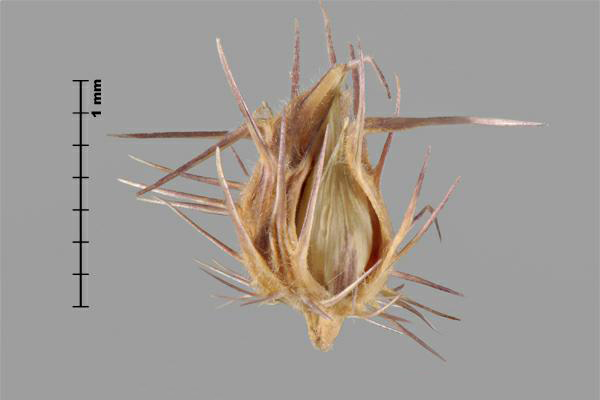Family
Poaceae
Common Name
Long-spined sandbur
Regulation
Primary Noxious, Class 2 in the Canadian Weed Seeds Order, 2016 under the Seeds Act.
Distribution
Canadian: Occurs in BC, ON, QC (Brouillet et al. 2016Footnote 1).
Worldwide: Native to North and South America (USDA-ARS 2016Footnote 2). Introduced to Europe (Belgium, Italy, Ukraine) and Australia (CABI 2016Footnote 3).
Duration of life cycle
Annual
Seed or fruit type
Spikelet in a fascicle (looks like a cup-like bur, here after it is called bur)
Identification features
Size
- Bur length: 5.0 - 7.0 mm
- Bur width: 3.0 mm
- Spikelet length: 2.0 - 4.0 mm
- Spikelet width: 1.5 mm
- Caryopsis length: 2.0 mm
- Caryopsis width: 1.0 mm
Shape
- Bur shape is broad oval, spikelet is teardrop-shaped, caryopsis shape is oval
Surface Texture
- Bur surface is dull and roughened with fine hairs
- Spikelet surface is smooth and papery with longitudinal nerves
- Floret surface is hard and roughened
Colour
- Bur colour is straw yellow with purple-tipped spines, spikelet, floret and caryopsis colour is pale yellow
Other Features
- Bur has 2 types of spines: a series of flattened spines with fused bases and small, thin spines around the base.
Habitat and Crop Association
Cultivated fields, irrigated orchards, vineyards, beaches, roadsides, railway lines, and other disturbed areas (Boydson 1997Footnote 4, Darbyshire 2003Footnote 5). A weed of corn crops in the Great Plains region of North America (Anderson 1997Footnote 6).
General Information
The burs of long-spined sandbur may be transported by farm equipment, contaminated hay, and other forage crops. Floating burs may travel through irrigated crops and into irrigation ditches (California Department of Food and Agriculture 2013Footnote 7).
Similar species
Southern sandbur (Cenchrus echinatus)
- Southern and long-spined sandbur are a similar size, shape and have similar spiny burs.
- Southern sandbur burs and spikelets are shorter than long-spined sandbur by up to 2.0 mm, and the burs are round rather than oval. The flattened, partially fused spines on long-spined sandbur form more than one whorl; southern sandbur has only one whorl of flat spines.
Photos





Similar species
